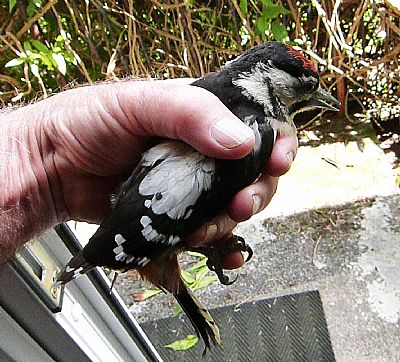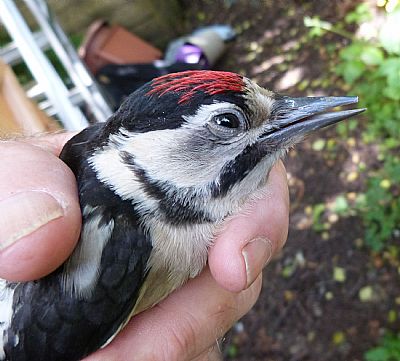WOODPECKERS
We have all heard the tok-tok-tok of the woodpecker battering loose bark on trees to disturb the grubs within. As we approach to get a better look, they either fly off or get around to the other side of the tree. There are 6 species in the UK.
Great spotted woodpecker : Dendrocopos major anglicus
The great spotted woodpecker is a striking black-and-white bird with a very distinctive bouncing flight. Adults have a deep red patch under the tail and males have a very clear sugar-lump-sized red patch on the back of the neck. It spends most of its time clinging to tree trunks and branches and announces its presence with a sharp call, like a ‘tchik’, often repeated in a long series or by drumming its bill very rapidly against tree trunks.
The great spotted woodpecker is a resident breeder, widespread throughout England, Wales and Scotland, except in the far north of mainland Scotland. It is uncommon or rare on most Scottish Islands, with densities generally declining north of the Great Glen. Scotland represents the north-west limit of the species’ range.[Scottish Wildlife Trust].
Firm identification can be confusing as the females and young differ from the adult males. That in the photo below appears to be an immature male. As it matures, it will loose the red crown, but retain some red on the nape of its neck.


Not a good way to do bird watching, but it is opportunistic. This one stunned itself against a home window. It was naturallu unhappy to have been picked up, but it didn't panic, instead holding on until it had calmed down and it got its breath back. It then flew away otherwise unscathed. If you look carefully, you see that the tip of its upper beack has snapped off. Being a woodpecker, you would imagine that it would be extremely tough, but perhaps as it was still young, it was still becoming stronger.
SCOTTISH WILDLIFE TRUST : https://scottishwildlifetrust.org.uk/species/great-spotted-woodpecker/
WOODLAND TRUST : https://www.woodlandtrust.org.uk/blog/2021/09/british-woodpecker-id/

